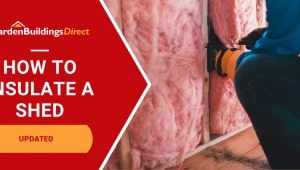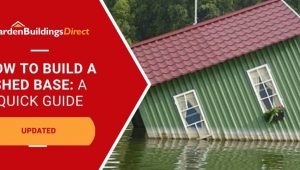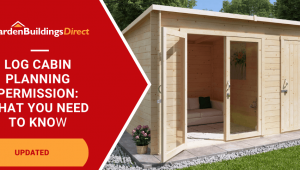Jump to:
Recent headlines have sparked concern about a so-called ‘garden shed tax,’ suggesting that shed owners could face higher council tax bills. However, this is a misunderstanding. Only a small number of garden buildings, and under specific conditions, may be subject to council tax.
In the vast majority of cases, you can rest assured, buying a new garden shed won’t mean paying any additional taxes. Here’s why the so-called ‘garden shed tax’ doesn’t apply to you.
Debunking the “New Tax” Myth in the UK
There’s no new law or separate “garden shed tax”. The phrase came from headlines suggesting councils have introduced a new tax on sheds and garden buildings. That’s not the case.
What’s happening is that local authorities are reviewing how existing council tax rules are applied. This particularly applies to garden buildings converted into self-contained living spaces. These rules have, in fact, existed for years. They’re part of standard council tax legislation used by the Valuation Office Agency (VOA) to decide when a property should have its own tax band.
There’s no new tax to worry about. Unless your shed or garden room is being used as a full living space, you won’t be affected. And those who already have a building of this nature would probably have already started to pay their new council tax rate.
When a Shed Can Trigger Council Tax
The increased attention isn’t about councils chasing “extra revenue.” It’s about identifying buildings that are being used as separate homes.
For instance, a garden shed fitted with a kitchen, bathroom, and a separate entrance from the main house. Another is if it’s rented out. In those cases, the VOA may decide it counts as an independent dwelling, which means it gets its own council tax band.
One more point: If you use the shed for business, the building may attract business rates instead of (or as well as) council tax.
How the Council Decides: Legal and Planning Side
The Valuation Office Agency (VOA) and local councils use planning and building records. Say, you’ve officially converted yours into an accommodation, that’s a strong indicator it’s no longer a simple shed. So, on top of the potential tax, planning permission is likely required too.
Adding insulation, plumbing, drainage, or fixed heating triggers Building Regulations approval. Again, those records prove the space is fit for living. Another factor that can support reclassification is having certified electrical work or plumbing in place, under Part P or other rules. This shows the shed functions as an independent unit, not just for hobbies.
When assessing cases, the VOA looks at the paperwork. This includes planning files and building control certificates, as well as any signs that the building is being used as a home. Those details hold more weight than what the structure looks like from the outside.
How to Avoid Issues
To stay on the safe side, keep everything straightforward. No separate meters, no new postal address, and keep any improvements linked to the main house.
Do this so as not to give VOA and your local council a reason to reclassify:
- Don’t install a fixed kitchen. This includes a fitted cooker, sink with permanent plumbing or built-in units.
- Don’t put in permanent bathroom plumbing. A fixed WC, shower or permanent waste pipe tied into mains drainage.
- Avoid separate utility supplies, meters or a separate postal setup. The VOA checks records, such as utility accounts, when deciding banding.
- Don’t let it be used as permanent rented accommodation, let alone if it doesn’t meet minimum safety and living standards. In 2023, a landlord in Kings Langley, Hertfordshire, was fined £8,000 for this reason.
- If you do any fixed electrical or structural work, get approvals. Use a registered electrician or notify Building Control where required (Part P). Keep completion certificates. Those documents prove the space meets standards.
- Before you convert, get pre-application advice or a lawful development certificate. Ask your local planning authority for pre-app advice or apply for a Lawful Development Certificate if you need legal clarity. That reduces surprises.
If the VOA or council contacts you
Don’t panic. Read their letter, note any reference numbers, and check if they’ve set a deadline. Gather proof that your garden building is still part of your main home. Then, pull together anything that shows your shed is still part of your main home. That could be dated photos, builder receipts, utility bills in your name, or paperwork proving it shares power or water with the house.
If you’re planning changes and aren’t sure how they’ll be viewed, ask your local planning office for written advice or contact the VOA directly before you start. And if you don’t agree with their decision, you can challenge it through the official appeal route on GOV.UK.
Now, what if you really want to live in a shed? This guide breaks down the rules, the risks, and the reality of living in one: Can You Live in a Shed? UK Beds in Sheds Law Explained





